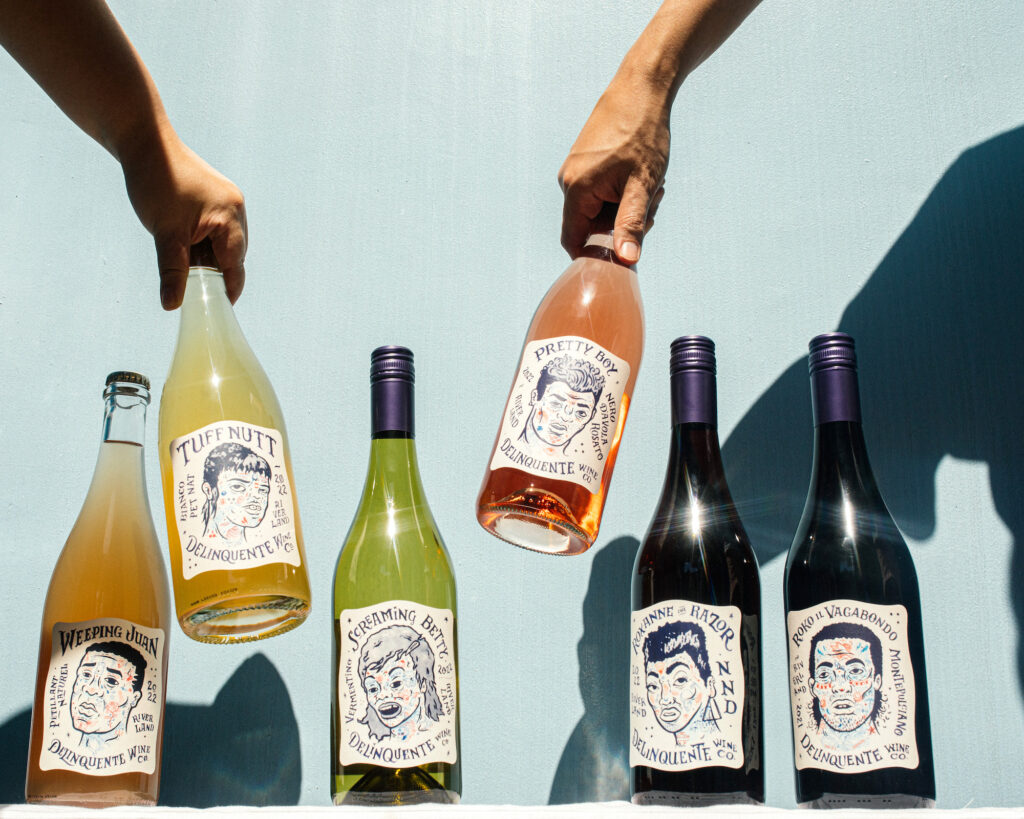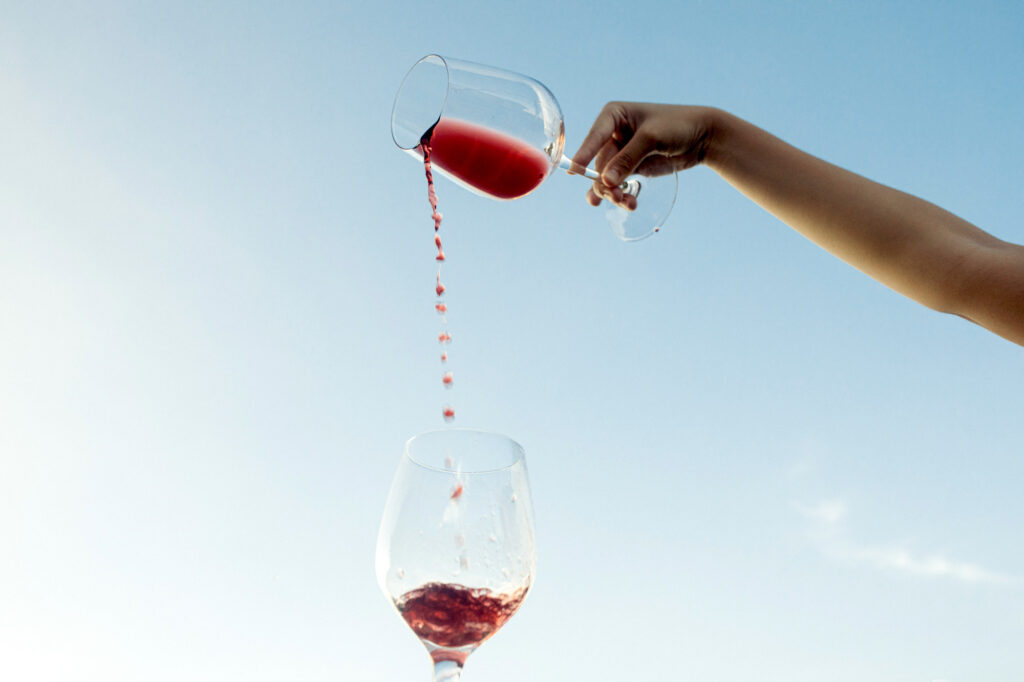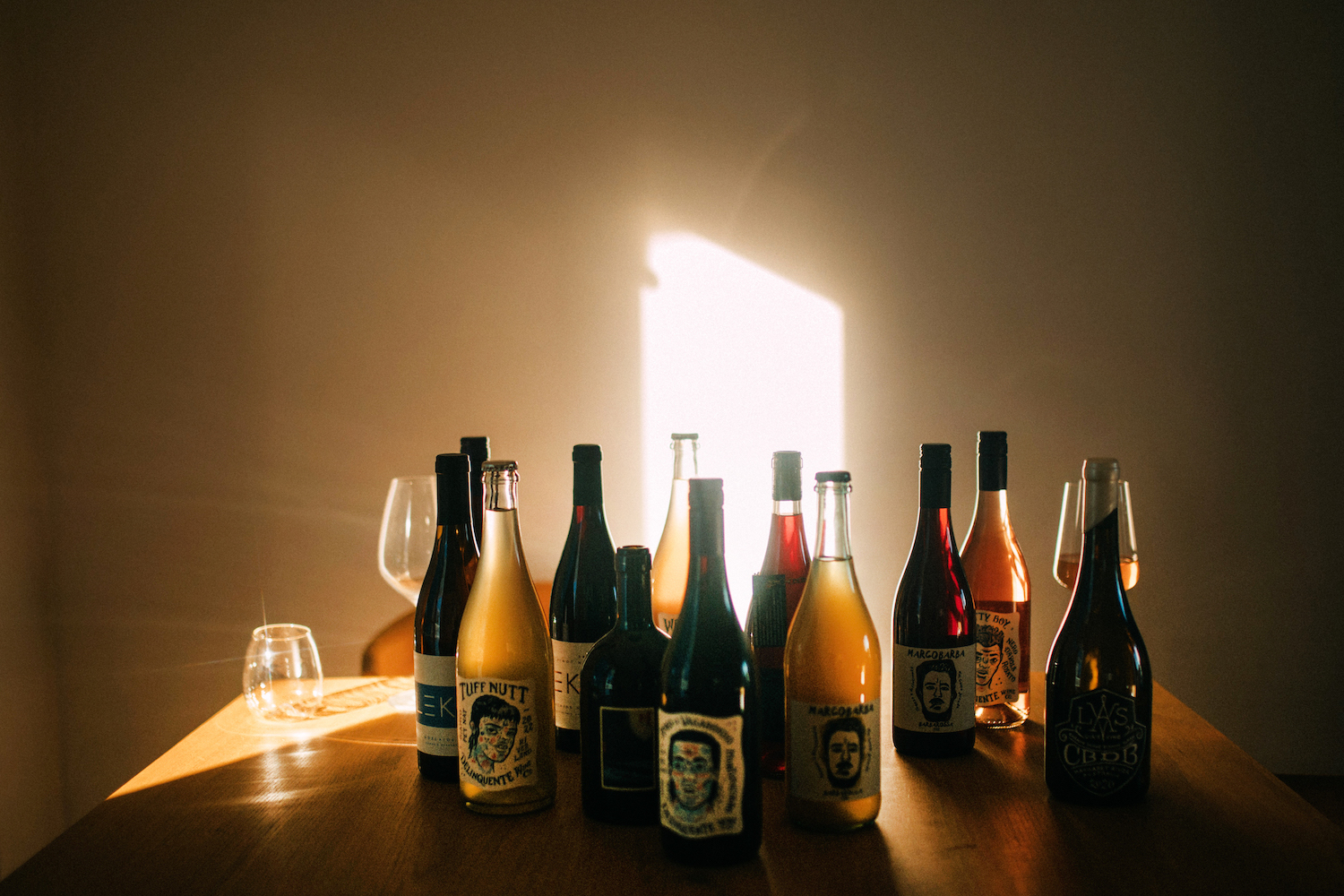In 2019, Joey Osmeña attended a wine fair in New York, ordering samples of natural wine so he could bring them home to the Philippines, a country where wine is arguably the least popular alcoholic beverage.
The idea of introducing a niche product to a beer- and gin-loving audience and into a market that was neither big nor robust enough to welcome what seemed like an obscure riff on a drink that Filipinos sometimes ordered only remained a risk for a few weeks when Osmeña and his business partner Paolo Monasterio were able to sell a few bottles. The pair eventually put up Bombvinos, one of the country’s first natural wine distributors.
Natural wine, or “natty” as it is sometimes referred to by its champions, isn’t exactly new. People have been making it for thousands of years now and is in fact considered the traditional way of making wine.
Restriction had a hand in this: The samples reached Osmeña and Monasterio in March 2020, the same time Manila went on lockdown due to COVID-19. People lucky enough to stay at home were conveniently prone to discoveries born out of long stretches of time—for example, that there was a version of wine that evoked a kind of effortless sophistication, creativity, and cheekiness that made the drink more accessible and exciting again.
Here was wine that, in addition to having flavor profiles and colors that were significantly different from those of conventional (non-natural) wines, were also packaged in bottles whose designs were reminiscent of indie movie posters and Japanese stationery—a deliberate departure from the serious, almost ascetic monochromatic labels donned by usual wines.
What exactly is natural wine?
Natural wine, or “natty” as it is sometimes referred to by its champions, isn’t exactly new. People have been making it for thousands of years now and is in fact considered the traditional way of making wine.
Yet its rise in different wine scenes across the world only happened in the past two decades, in the early 2000s in Paris and the US, with the latter seeing a resurgence in 2020. There is no standard definition for natural wines but generally speaking, it is pure fermented grape juice made with little-to-no-intervention and without any additives such as acid and sugar, uses grapes (often handpicked) not sprayed with herbicides or pesticides, is often unfiltered (which makes them cloudy), and relies on natural yeast instead of lab-grown yeast.
For context, American winemakers can choose from over 60 approved additives to their wines without having to list them on the label. “A lot of conventional wines are made with the intention of making them taste predictable, consistent, and similar to styles of wine that people already know and love,” says Osmeña and Monasterio. On the contrary, natural wine hints at a whole spectrum of flavors that might be entirely unique in the world of wine.
Justin Apolonio and Vanessa Abat-Apolonio, founders of Some Love, say that the flavors of natural wine can depend on the intent and creative direction of the winemaker, but that consumers can expect much of it to taste “lighter, brighter, more lively and aromatic.” It’s also less tannic, which, according to the Bombvinos team, makes it a great complement to Filipino food the way a sweet pale lager can cut through the fattiness of something like chicken inasal or grilled liempo. Some people just say that it tastes alive.
As a commodity, the stuff carries expectations of moral superiority: Is it more ethically produced? Is it actually better for the environment?
As a commodity, the stuff carries expectations of moral superiority: Is it more ethically produced? Is it actually better for the environment? Like any organic-adjacent food and beverage movement, the debates surrounding natural wine—from its ethics down to its definition—are endless.
In the Philippines, where we have yet to truly reckon with the food and beverage industry’s critical context, the silver lining is that the natural wine movement is helmed by young entrepreneurs who share much of its idealism, love for innovation, and attention to context.
Good Morning Wines: What’s more niche than niche?
To be fair, the first distributors of natural wine in the Philippines didn’t get into the business with this vague notion of natural wine as the kinder alternative to mass produced wine. “Natural wine is not a replacement for conventional wine, but an enriching complementary addition to the wine world. Consumers simply now have more to choose from. Those who prefer classic wines or more standardized winemaking can rely on conventional wines, and those who have an interest in letting the grapes and terroir speak now have the choice of natural wines,” says Micah Cabral, who co-founded Good Morning Wines with Dimitri Roleda in 2022.
The brand is the first Japanese natural wine importer in the Philippines. From that fact alone, Cabral and Roleda understood that although their fellow importers faced the same challenge of selling a niche product, theirs was twofold: People don’t normally associate winemaking with Japan, and the few who do are probably not thinking about natural wines. Japanese natural wines—fruity, floral, with mineral characteristics and a distinguishable fresh acidity—are also more expensive than their counterparts.
But the pair, who had been long time admirers of Japanese culture, knew that these wines were special. The ethos of excellence and ingenuity ran in Japanese winemaking, as it did in their cuisine and art.
“To us, it seems like they’re able to make anything they touch their own, and they do it really well. This culture is reflected in their winemaking, and a few sips from any bottle will show anyone how special Japanese winemaking is… we want to share their amazing work and to find others who share our interest in all the ways that wine could (not should) be.” As Cabral explains, Japan’s varied climate, geography, and culture—its cooler and warmer regions and unique soil compositions across the country—make for varied and distinct flavor profiles that are delicate and balanced. “Just like Japanese cuisine,” they add.
Cabral and Roleda met in 2021, long after each of them had explored their interest in wine and alcohol fermentation. Roleda made his own mead during his law school days and Cabral, who introduced natural winemaking to him, would bring home natural wine from her trips to Japan. The idea of starting her own wine importation business eventually came to fruition when she and Roleda finally took on the challenge of sourcing.
“The domestic market in Japan for their wines is quite strong, leaving some winemakers with little to no bottles available for export. It was a lot of research and risk-taking just to source our wines,” say Cabral and Roleda.
“The domestic market in Japan for their wines is quite strong, leaving some winemakers with little to no bottles available for export. It was a lot of research and risk-taking just to source our wines,” say Micah Cabral and Dimitri Roleda of Good Morning Wines.
Officially launching in August 2022, Good Morning Wines brought over natural wines from the Japanese producers Grape Republic and Fattoria Al Fiore. The wines—with their “distinct profile” that imparted a “sensory experience”—were sold out by the end of the year. The “risk-taking, dedicated, and skillful winemakers” of Japan make it a compelling and unique geographic category in wine, and Good Morning Wines, while fairly new, could be credited for bringing in an exciting option for people looking to try natural wines.
If people don’t know where to start with these wines, taking a cue from what they feel like eating is a good place to start: “Most of our wines would go really well with Japanese food, even the reds go well with sushi. Our white sparkling wine goes well with almost anything—cheese, grilled seafood, and even The Daily Knead’s mango caramel cake. The sparkling rosé goes very well with salmon or trout sashimi and with a birria taco. Recently, we also tried our still red wine (Bailey A) with Vargas Kitchen’s Icebox (a frozen cake with cream, chocolate, and chiffon), and we were surprised how they blended so well together.”
The Aussie natural wine experience

Elsewhere in Australia, Justin and Vanessa had found a new home in Perth with its vibrant food and wine culture. Quality produce, seafood, craft beer, and cider were a big thing in the city, but it was low-intervention wines that, over time, became the thing that the couple would bring with them when they returned to the Philippines.
Before venturing into importing, they first made sure to study the supply chain and where they stood in the landscape of natural wine distribution; it was also necessary to gain expert knowledge if they were going to be distributing a product that not many people knew about.
In Australia, Justin completed a WSET (Wine & Spirit Education Trust) Level 3 Qualification in Wine, which lets one assess wines accurately as well as explain its style and quality. The next step was to create a brand that was strong enough to reach a lot of people and to build a memorable presence—from writing to photography, putting up private events, and getting their wines listed in restaurants, and eventually pop-ups and collaborations. In April, they collaborated with Your Local’s Patrick Go to create a series of wine pairings for Go’s six-course East Asian tasting menu.
Besides brand and community-building, the other crucial bit of work that Justin and Vanessa Apolonio focused on was developing a service-focused approach that Some Love would soon be known for: Apart from retail, the company also offers workshops and private wine tastings.
Besides brand and community-building, the other crucial bit of work that the two focused on was developing a service-focused approach that Some Love would soon be known for: Apart from retail, the company also offers workshops and private wine tastings. For them, effectively communicating what makes a certain bottle unique was key to maximizing the overall drinking experience. The two have also recently opened Bibio in Makati to bring the natural wine bar experience that they loved abroad here in the Philippines.
If Japan is a niche geographic category in wine, Australia remains one of the world’s best known wine producers, with a winemaking tradition that could be traced back to over two centuries and spans 65 wine regions across many climates. Natural wine had come in over a decade ago, at a time when the Australian wine industry was suffering from a drought and a massive oversupply; it also happened that during that time organic food had swept much of the country, and eyes were on farming conditions and practices, including, according to Wine Enthusiast, “overly technical vinification.”

The industry had to reckon with itself, and when natural wine came in—produced through a “nothing added, nothing taken away” approach—it was considered a disruptive force, their pioneers consequently hailed as radicals.
While this is hardly the kind of market that the owners of Some Love were introducing natural wine to, the wife-and-husband team shares the same philosophy of wine-as-experience, of wine as a source of joy. Flavor remains their priority, but it’s understood to be a result of what the pair explains as character, nuance, intention, and a clear purpose, best enjoyed with good company and a good understanding of how the wine came to be: “When the wine has nothing to hide behind, you get to experience the nature of the land and the true care, craftsmanship, artistry, and personality of the growers and winemakers,” Justin and Vanessa add.

That the eclecticism and experimental nature of Australian natural wines were instrumental in re-energizing the Australian wine industry is reassuring for importers who might be considering it for their business, as was the case for Some Love, whose approach to natural wine is, again, centered around the totality of an experience. On their online shop, their wines are listed according to, besides style and type, mood: “Curious & Rebellious,” “Soulful Pondering,” and “Celebration Energy.”
Bringing Australian natural wines to the Philippines brings its own unique set of hurdles, including having a nuanced understanding of the market. Some Love, which also imports wines from Germany and France, thinks a lot about where it sees itself in the landscape of natural wine distribution in the Philippines. “There’s a place for different kinds of wine. Affordable mass-produced wines are non-intimidating and usually people’s first introduction to wine. Commercial brands in the middle and even luxury price ranges give people an accessible and reliable option when they don’t feel like having to choose,” say Justin and Vanessa.
Adopting the natural wine style
Outside the consensus that Philippine consumers prefer beer and spirits over wine are these small populations in highly urbanized cities where many, if not all, of these natural wine importers are based. Here, the confluence of a fast-growing restaurant scene and growing access to curated and artisanal online stores has inevitably spurred increasingly sophisticated tastes.
A report by the United States Department of Agriculture calls the Philippines among the “most exciting” wine markets in the world, with traders forecasting the country’s wine imports from the US to increase five percent annually over the next three years to $70 million in 2025. In 2021, the Philippines was the largest US wine market in Southeast Asia, surpassing major transshipment destinations such as Singapore.
A report by the United States Department of Agriculture calls the Philippines among the “most exciting” wine markets in the world, with traders forecasting the country’s wine imports from the US to increase five percent annually over the next three years to $70 million in 2025.
The drivers of such growth? Younger consumers with growing health awareness (wines supposedly being the healthier alternative to beer and spirits), a small subset of which are millennials with a taste for difficult or unusual beverages. In Makati, where natural wine has found its home in wine bars, restaurants, and cafes, natty has become the subject of a burgeoning subculture among creatives or just anyone curious about unusual variations of wine.
This is demand that, while unremarkable, isn’t negligible: its slow but steady growth over the years is an interesting manifestation of a growing food scene (and vice versa), and it seems to be saying something significant about consumer tastes, particularly how much Filipino consumers are now thinking more about food and wine pairings. So while the Philippines produces almost no wine, the question of which wine pairs best with Filipino food, while probably secondary to beer or cocktail pairings, isn’t completely irrelevant.
Lisandro Claudio writes that at the moment, big flavor (Bordeaux and Napa cabernets) seems to be the preference among Filipino consumers, but goes on to explain that there has been an increasing number of Pinot Noir drinkers—palates demanding more subtle wines. Good (and relatively inexpensive) Pinot Noir being notoriously difficult to find here in the Philippines, an option worth really getting into is natural wine.
Yet the whole point, again, is that natural wines aren’t just alternatives to conventional wines. They’re in a category of their own, offering unique flavor profiles that happen to be lighter and might just pair really well with your favorite Filipino food.
“The wines that are widely offered in the Philippines (and all over the world, really) are basically emulating flavors of prized regions… natural wines [taste] so vastly different and distinct from those popular styles, and opened our palates to a much bigger world of possible flavors. We want to do the same for more and more Filipinos,” say the owners of Bombvinos.
Possible pairings

When the Bombvinos team brought samples of natural wine to the Philippines, the original plan was to put these wines on restaurants’ wine lists. After postponing the plan due to COVID-19, Osmeña and Monasterio eventually did end up working with restaurants such as Metiz, Linamnam, and Toyo Eatery.
Deciding which wines made it to these restaurants’ wine lists was a largely collaborative effort. “Before we do tastings, we usually have a chat with one of the chefs and ask them ahead of time if there are any bottles on our wine list that they specifically want. We inquire if they are looking for any particular wines, such as a clean Petnat [short for Pétillant Naturel, sparkling wines that finish their fermentation in the bottle] a fun skin-contact wine, or an easy red,” Osmeña and Monsaterio explains. During tastings, the two talk about the current menu with the chefs and their team, and, over a few bottles of natural wine, try to discover which ones complement their food.
When the Bombvinos team brought samples of natural wine to the Philippines, the original plan was to put these wines on restaurants’ wine lists. After postponing the plan due to COVID-19, Osmeña and Monasterio eventually did end up working with restaurants such as Metiz, Linamnam, and Toyo Eatery.
It’s worth noting that the abovementioned restaurants have made their names as purveyors of a certain kind of Filipino food: “elevated” and progressive takes on classics that Osmeña and Monasterio themselves see as instrumental to the growth of the local restaurant scene. “It’s their progressive nature that’s pushing the growth of the Filipino food scene. They share the same philosophy and ethos as us, wherein natural wines make great pairings with Filipino food,” they said.
Bombvinos has indeed built a brand around that very idea, with Osmeña and Monasterio recommending pairing natural wines with adobo flakes, inasal, pork barbecue, liempo, and even Potato Corner, Jollibee, McDonald’s, and potato chips. With a portfolio that has a strong focus on Austrian wines (“they’re so well made with very precise flavors”) and relatively affordable and versatile wines that could be enjoyed on their own, Bombvinos maintains its emphasis of accessibility and fun as key in their business approach. “Think tropics—you’re at the beach looking at the pink sky, devouring some fresh fruits with your best friends,” goes the description for their No Es Pituko Rosé 2021.
The natural wine movement in the Philippines is built on the same things that fuel its global counterparts (approachability, experimentalism, and community), and what it supposedly lacks given its nascency and low demand seem to be, on the contrary, an opportunity to expand palates, usher in new possibilities for wine in the Philippines, and serve as an essential element in building and sustaining an ever-evolving, dynamic food scene (and vice versa).
Last Apr. 16, Good Morning Wines, Some Love, and Bombvinos, along with Gran Hacienda Wines and Supernatural Wine, put up the first Manila Natural Wine Fiesta in The Alley at Karrivin. A ticket to the event granted attendees samples of natural wine from all over the world; rounding out the experience were inihaw dishes by Toyo Eatery. The collaboration among these young importers not just signals growing interest in natural wines, but also underscores the role of community in building up a niche product.
For anyone looking to join the growing natural wine community in the country and start importing natural wines, Good Morning Wines, Bombvinos, and Some Love each has advice to offer.
“Research and learning are paramount—you have to know the product you’re bringing in, what sets it apart, and how it fits into the market; choosing which bottles to carry requires the same effort and consideration. Equally important is the ability to create a good, honest, and trusting relationship with the winemakers you work with. Finally, you should also accept that, for a very niche product, it will take some time to find your market, but you eventually will; focus on who you are, and your people will find you,” say Cabral and Roleda.
“Understand your goals and who you would like to be as an importer. It’s important to study your market, what need you are trying to satisfy and how you want to go about it,” say Justin and Vanessa Apolonio of Some Love.
The importance of understanding how your product will fit into the market is also echoed by the owners of Some Love: “Understand your goals and who you would like to be as an importer. It’s important to study your market, what need you are trying to satisfy and how you want to go about it. Then you can choose an approach, what to study up on, and even winemakers that best represent you and vice versa,” say Justin and Vanessa.
All three brands have since put up (or are currently putting up) brick and mortar locations, letting them share in person their extensive yet intimate and highly personal curations that speak the most earnest rarefied language—the kind not everyone would necessarily demand or expect from a bottle of wine.
“If we were centered on profitability we’d be scared to make more than half the decisions we make—but we recognize that we’re doing something that not a lot of people have done before, which gives us the freedom to do things that haven’t been done before,” says the Bombvinos team.





